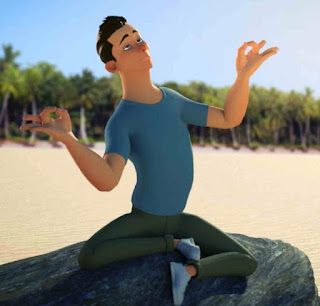 |
| Mickey Mouse from "The Illusion of Life" |
Perfectly mirrored limbs, identical angles, and evenly balanced weight all scream “mannequin,” not “living being.” Real life — and good animation — is full of asymmetry.
Avoid Symmetry
Take a look at Mickey Mouse on the left (taken from the Disney classic "The Illusion of Life") and ask yourself which version of Mickey's pose is stronger. Clearly, it's the one of the right. It has much more life and dynamism. Similarly, take a look at the three Disney ducks below, Huey Dewey and Louie, also taken from "The Illusion of Life". The same principle applies.
For more resources on how to plan animation (including how to use thumbnail sketches and live action), follow these links:
Asymmetry Creates Believability.
In reality, people rarely stand or move in perfect balance. A weight shift to one side, a tilted head, or one arm higher than the other adds natural variation that our brains read as authentic.
Asymmetry adds Visual Interest
Symmetry is predictable; asymmetry draws the eye. By breaking the mirror, you guide the audience’s attention to what matters — a gesture, a prop, or a facial expression.
Asymmetry communicates personality. A slouched shoulder can show weariness, a cocked eyebrow adds mischief, a twist in the spine conveys tension. Asymmetry lets you inject nuance into body language that symmetry can’t match.
Avoid Twinning
Asymmetry helps avoid ‘twinning.’
Twinning — when both sides of the body do exactly the same thing — flattens the energy of a shot. By offsetting one arm, hand, or leg, you can make the pose more dynamic.
Next time you’re blocking a scene, tilt the hips, offset the shoulders, break the pose in ways that feel natural yet visually striking. Your characters will breathe, your animation will pop, and your audience will feel the difference — even if they can’t put their finger on why.
Resources on Planning Animation
 |
| Acting Pose by Alex Southcombe |
- Medusa Thumbnails by Milt Kahl
- Why thumbnail sketches need facial expressions
- Thumbnail sketches by Pixar's Victor Navone
- Thumbnailing Mrs Copperbottom from "Robots"
- Thumbnailing "Boog" from "Open Season"
- How to Animate a Dialogue Shot
- How to Plan a Pantomime Shot
- How to Plan a Creature Animation Shot
- How to Use Live Action Reference to Plan Animation
- Body Language for Animators
To find out more about Animation Apprentice, click here for a link to Frequently Asked Questions. To sign up for our next classroom at Animation Apprentice, follow this link.


No comments:
Post a Comment